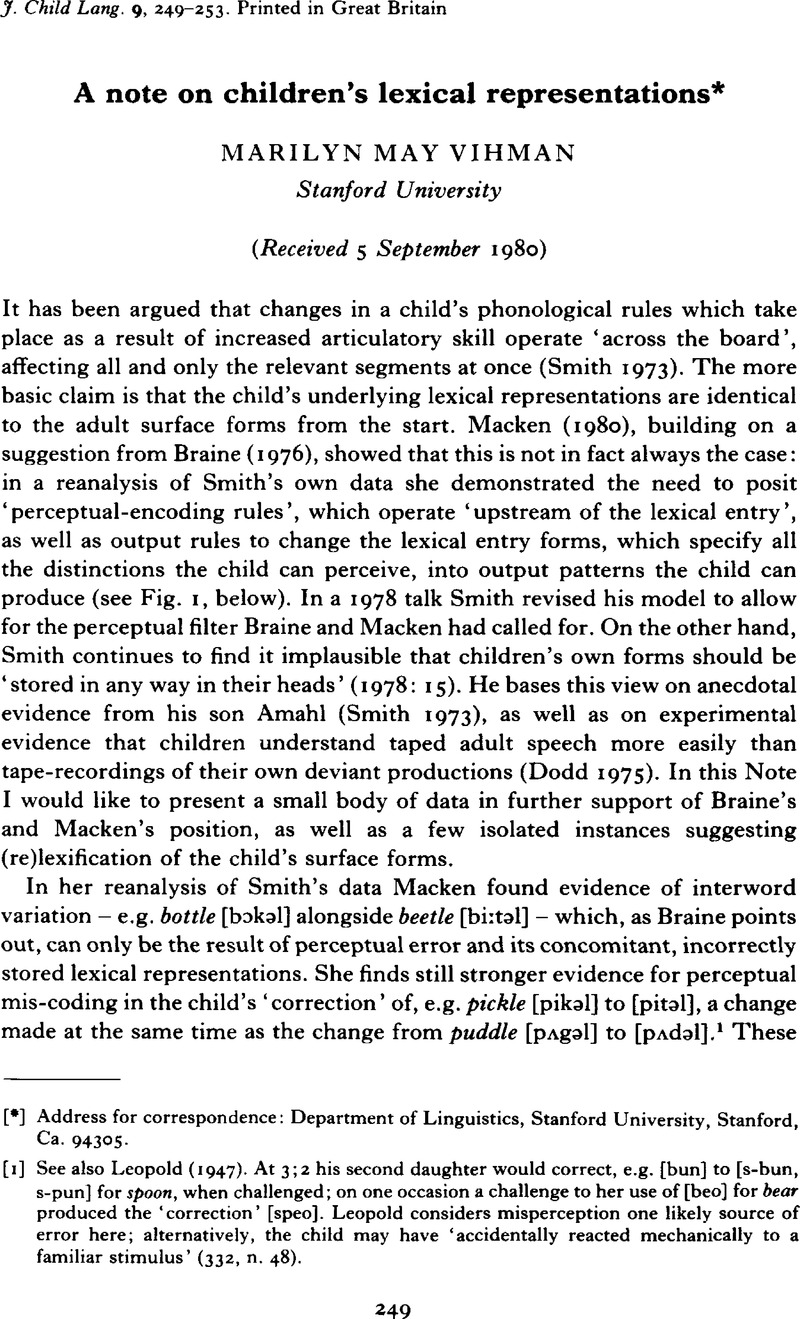Crossref Citations
This article has been cited by the following publications. This list is generated based on data provided by Crossref.
Matthei, Edward H.
1989.
Crossing boundaries: more evidence for phonological constraints on early multi-word utterances.
Journal of Child Language,
Vol. 16,
Issue. 1,
p.
41.
McGregor, Karla K.
and
Schwartz, Richard G.
1992.
Converging Evidence for Underlying Phonological Representation in a Child Who Misarticulates.
Journal of Speech, Language, and Hearing Research,
Vol. 35,
Issue. 3,
p.
596.
Suomi, Kari
1993.
An outline of a developmental model of adult phonological organization and behaviour.
Journal of Phonetics,
Vol. 21,
Issue. 1-2,
p.
29.
Thomas, Eleanor M.
and
Sénéchal, Monique
1998.
Articulation and phoneme awareness of 3-year-old children.
Applied Psycholinguistics,
Vol. 19,
Issue. 3,
p.
363.
Bassano, Dominique
2000.
L'acquisition du langage. Volume I.
p.
137.
Bertoncini, Josiane
and
de Boysson-Bardies, Bénédicte
2000.
L'acquisition du langage. Volume I.
p.
95.
Storkel, Holly L.
2004.
The Emerging Lexicon of Children With Phonological Delays.
Journal of Speech, Language, and Hearing Research,
Vol. 47,
Issue. 5,
p.
1194.
Menn, Lise
Schmidt, Ellen
and
Nicholas, Brent
2013.
The Emergence of Phonology.
p.
460.
OTA, MITSUHIKO
and
GREEN, SAM J.
2013.
Input frequency and lexical variability in phonological development: a survival analysis of word-initial cluster production.
Journal of Child Language,
Vol. 40,
Issue. 3,
p.
539.
Storkel, Holly L.
Maekawa, Junko
and
Aschenbrenner, Andrew J.
2013.
The Effect of Homonymy on Learning Correctly Articulated Versus Misarticulated Words.
Journal of Speech, Language, and Hearing Research,
Vol. 56,
Issue. 2,
p.
694.
Cuccio, Valentina
2014.
From a Bodily-based Format of Knowledge to Symbols. The Evolution of Human Language.
Biosemiotics,
Vol. 7,
Issue. 1,
p.
49.
Wang, Lei
and
Chen, Chan
2016.
Assessing Chinese Learners of English.
p.
101.
Storkel, Holly L.
2018.
Implementing Evidence-Based Practice: Selecting Treatment Words to Boost Phonological Learning.
Language, Speech, and Hearing Services in Schools,
Vol. 49,
Issue. 3,
p.
482.
Tessier, Anne‐Michelle
2019.
U‐shaped development in error‐driven child phonology.
WIREs Cognitive Science,
Vol. 10,
Issue. 6,
Pye, Clifton
Berthiaume, Scott
and
Pfeiler, Barbara
2020.
Northern Pame-Spanish language acquisition in the context of incipient language loss.
International Journal of Bilingualism,
Vol. 24,
Issue. 2,
p.
246.



